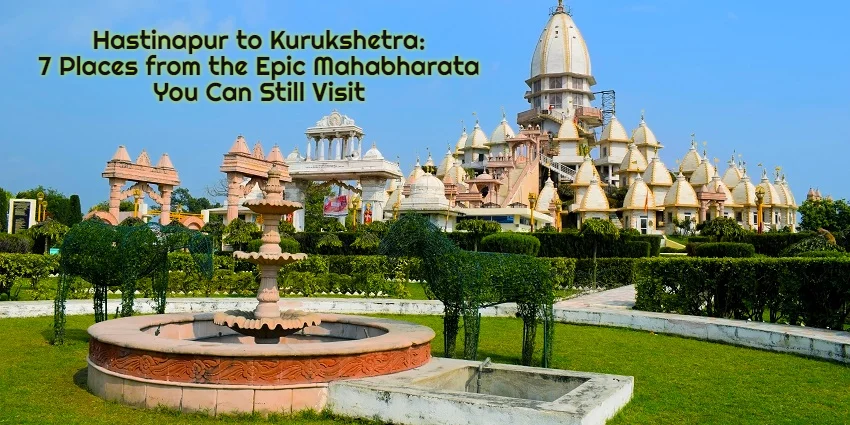The Mahabharata is more than just a mythological narrative; it defines the reality of India’s spiritual, cultural, and ethical identity. One of the factors that give the Mahabharata special significance is that many of its sites still exist in present-day India, thus allowing pilgrims and participants to walk in the very same style of landscape that cultural heroes engaged in, thus collapsing the vista of mythology and reality.
Among the numerous sites awarded a living memory of the Mahabharata, is Hastinapur (the home and capital of the Kaurava and Pandava princes), and Kurukshetra (the receiver of the divine message known as the Bhagavad Gita), among others discussed below. From the legendary capital of the Kauravas and Pandavas to the sacred battlefield of dharma, these Mahabharata places are a journey where myth and reality beautifully merge.
Here are 7 magnificent places from the Mahabharata you can visit today, still resonating with spiritual stories and ancient history.
1. Hastinapur – The Capital of the Kuru Dynasty
Located in the Meerut district of Uttar Pradesh, Hastinapur is the heart of the Mahabharata. This was the site of the royal palace where the epic’s destiny unfolded, from the childhood of the princes to the game of dice that started it all. A visit here is a direct immersion into the story.
- Highlights: The Pandeshwar Temple, dedicated to Lord Shiva, the Draupadi Ghat, and a temple for Karna. This is a crucial stop on any Mahabharata trail.
- Why Visit: This ancient city is both a historical site and a sacred pilgrimage for Hindus and Jains, who also have deep-rooted connections here.
2. Kurukshetra – The Battlefield of Dharma
Perhaps the most iconic of all Mahabharata locations, Kurukshetra in Haryana is the “Land of Dharma.” It was here that the great battle was fought, and where Lord Krishna delivered the divine wisdom of the Bhagavad Gita to Arjuna.
- Highlights: Jyotisar, the very spot where the Gita sermon took place; Brahma Sarovar, a sacred water tank; and the Kurukshetra Panorama Museum, which vividly depicts the battle.
- Why Visit: For anyone who seeks a deeper spiritual connection, Kurukshetra offers a powerful and profound experience far beyond a simple battlefield visit.
3. Indraprastha – The City of the Pandavas (Delhi)
Today’s Delhi is believed to have been the glorious city of Indraprastha, built by the Pandavas. According to the epic, it was a city of immense wealth and strategic brilliance.
- Highlights: The Purana Qila (Old Fort) is considered by many historians to be the site of ancient Indraprastha.
- Why Visit: Visiting Delhi with the knowledge of its Mahabharata roots gives you a unique mythological lens to view the capital city’s rich and layered history.
4. Mathura – The Land of Krishna’s Early Life
A visit to the Mahabharata places is incomplete without exploring Krishna’s origins. Mathura, his birthplace on the banks of the Yamuna River, is filled with temples and stories from his childhood.
- Highlights: The Krishna Janmabhoomi Temple and Vishram Ghat.
- Why Visit: To gain a deeper understanding of Krishna’s journey from a playful child to a master strategist and divine mentor in the great war.
5. Varanasi – The Eternal City in the Epic
While more famously known for its spiritual significance in general, Varanasi (Kashi) also holds a place in the Mahabharata. It is said that the Pandavas visited this city on their pilgrimage, seeking blessings from Lord Shiva.
- Highlights: The Kashi Vishwanath Temple and the sacred ghats of the Ganges River.
- Why Visit: Varanasi connects the epic’s narrative to the perennial spiritual heart of India, where devotion and rituals have been a part of life for millennia.
6. Dwarka – Krishna’s Kingdom
After the war, Lord Krishna established his kingdom in Dwarka, Gujarat. This city is an important part of the Mahabharata trail, representing Krishna’s role as a king and protector.
- Highlights: The famous Dwarkadhish Temple and the intriguing ruins of the submerged city found near the coast.
- Why Visit: Dwarka offers a fascinating blend of mythology and archaeology, providing a unique perspective on Krishna’s life beyond the battlefield.
7. Rameshwaram – Pandavas’ Pilgrimage After the War
Located in Tamil Nadu, Rameshwaram holds a crucial place in the epic. After the war, the Pandavas are believed to have traveled here to seek forgiveness for the sins of battle and worship Lord Shiva.
- Highlights: The Ramanathaswamy Temple, which houses a sacred Jyotirlinga, and the Agni Theertham.
- Why Visit: This site represents the Pandavas’ spiritual journey from warriors to seekers of peace and divine purification, making it a powerful and necessary stop on the Mahabharata trail.
Conclusion
The Mahabharata is not just a story of war and dharma; it is a living history carved into the geography of India. From the ancient ruins of Hastinapur to the sacred battlefield of Kurukshetra, these Mahabharata locations allow a traveler to personally connect with the epic and its timeless lessons. Visiting these 7 Mahabharata places is more than a simple tourist trip—it’s an experience that links you to the very cultural, spiritual, and historical essence of India, reminding us that the epic’s teachings are as relevant today as they were thousands of years ago.
Must Read: Live Like Royalty: Explore 7 of Rajasthan’s Best Palaces Converted into Hotels for Your Ultimate Royal Stay
FAQs (Frequently Asked Questions)
Q1: Are these places truly related to the Mahabharata epic?
Ans: Yes. All of these locations have deep roots in the Mahabharata, with historical and mythological significance mentioned in ancient texts and local folklore. They are considered sacred pilgrimage sites for many.
Q2: Which of these Mahabharata sites is the most important to visit?
Ans: While all sites are significant, Kurukshetra in Haryana is often considered the most important due to it being the battlefield where the great war was fought and where Lord Krishna delivered the Bhagavad Gita sermon.
Q3: Can I visit all these Mahabharata locations in a single trip?
Ans: It would be difficult to visit all seven in one short trip as they are spread across various states in India. It is best to plan your travel based on a specific region, such as North India (Hastinapur, Kurukshetra, Delhi) or South India (Rameshwaram).
Q4: What is the main significance of Hastinapur in the Mahabharata?
Ans: Hastinapur was the ancient capital of the Kuru dynasty, which was the home of both the Pandavas and Kauravas. It is where the main plot of the epic, including the game of dice and the rivalry, originated.
Q5: What is the significance of the Bhagavad Gita at Kurukshetra?
Ans: The Bhagavad Gita is a 700-verse scripture that records the conversation between Lord Krishna and Arjuna before the war. The sermon, which took place on the battlefield, is a central philosophical and spiritual text in Hinduism.
Q6: Besides the Mahabharata connection, what else is there to see at these places?
Ans: Many of these sites offer a rich cultural experience. For example, Hastinapur is also a significant pilgrimage site for Jains, Mathura and Dwarka are famous for their temples dedicated to Krishna, and Varanasi is globally renowned for its spiritual essence along the Ganges River.







